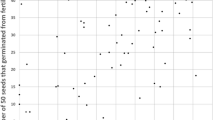Abstract
The loss of yield resulting from infestation with potato leafhoppers,Empoasca fabae (Harris), was measured in a group of potato selections (Solatium tuberosum subsp.tuberosum). For 6 years in which 300 different clones were tested, the average loss of yield was 39%. The correlation over clones between level of infestation and percent hopperburn equaled 0.56; between level of infestation and loss of yield 0.36; and between percent hopperburn and loss of yield 0.41. Each coefficient is significant at P=0.01.
Significant differences were found in levels of infestation and in percent hopperburn among the selections, but even those selections with the most resistant foliage had greatly reduced yields when infested. No selections were found that consistently produced a normal yield when infested with leafhoppers. The low level of infestation on the more resistant clones, however, may make chemical control at lower rates more effective.
Resumen
Las pérdidas en la cosecha causadas por el saltahojas de la papa,Empoasca fabae (Harris), fueron medidas en un grupo de selecciones de papa (Solarium tuberosum sub sp.tuberosum). Durante seis años en los cuales se probaron 300 clones diferentes, el promedio de perdida en la cosecha fue de 39%. La correlación de los clones entre niveles de infestación y porcentaje del daño de los saltahojas fue igual a 0.56; entre niveles de infestación y pérdidas en la cosecha fue 0.41. Cada uno de los coeficientes es significativo al nivel de P = 0.01.
Se encontraron diferencias significativas en los niveles de infestación y en el porcentaje de daño entre las selecciones pero, aquellas selecciones que tuvieron el follaje más resistente, tuvieron también las más grandes reducciones en la cosecha cuando fueron infestadas. No se encontró ninguna selección que produjera una cosecha normal cuando estuvo infestada con saltahojas. Los niveles bajos de infestación encontrados en los clones más resistentes, sin embargo, pueden reducir la frecuancia en la aplicación del control químico con mejores resultados.
Similar content being viewed by others
Literature Cited
Apple, J.W. and C.Y. Arnold. 1945. The use of tuber specific gravity in determining the effectiveness of leafhopper insecticides. Am Potato J 22: 339–343.
Ball, E.D. 1918. Leaf burn of the potato and its relation to the potato leafhopper. Science 48: 194.
Ball, E.D. 1919. The potato leafhopper population and hopperburn that it causes. Wisconsin Dept Agric Bull No. 23: 76–102.
Federer, W.T. 1961. Augmented designs with one-way elimination of heterogeneity. Biometrics 17: 447–473.
Granovsky, A.A. 1944. The value of DDT for the control of potato insects. Am Potato J 21: 89–91.
Granovsky, A.A. and A.G. Peterson. 1954. Evaluation of potato leaf injury caused by leafhoppers, flea beetles, and early blight. J Econ Entomol 47: 894–902.
Horsfall, J.G. and R.W. Barratt. 1945. An improved grading system for measuring plant diseases. Phytopathology 35: 655.
Linn, M.B., J.W. Apple and C.Y. Arnold. 1948. Leafhopper control with DDT in relation to length of season, quality and yield of 17 potato varieties. Am Potato J 25: 315–328.
Maughan, F.B. 1937. Varietal differences in insect populations and injuries to potatoes. Am Potato J 14: 157–161.
Peterson, A.G. and A.A. Granovsky. 1959. Relation ofE. fabae to hopperburn and yield of potatoes. J Econ Entomol 43: 484–487.
Prasad, S.K. 1961. Quantitative estimation of damage to potatoes caused by potato leafhopper,E. fabae (Harris). Indian Potato J 3: 105–107.
Sleesman, J.P. 1936. Influence of variety on potato leafhopper populations. Ohio Agric Exp Stn Bull 561: 43.
Sleesman, J.P. and F.J. Stevenson. 1941. Breeding a potato resistant to the potato leafhopper. Am Potato J 18: 280–298.
Wolfenbarger, D.O. and J.W. Heuberger. 1946. Potato yields from different potato leafhopper densities. Am Potato J 23: 389–395.
Wressell, H.B. and G.R. Driscoll. 1964. The use of systemic insecticides for control of the potato leafhopperE. fabae, and effect on potato yields. J Econ Entomol 57: 992–993.
Author information
Authors and Affiliations
Rights and permissions
About this article
Cite this article
Sanford, L.L., Webb, R.E. Loss of yield in potato selections infested with potato leafhoppers. American Potato Journal 54, 581–586 (1977). https://doi.org/10.1007/BF02855285
Received:
Issue Date:
DOI: https://doi.org/10.1007/BF02855285




